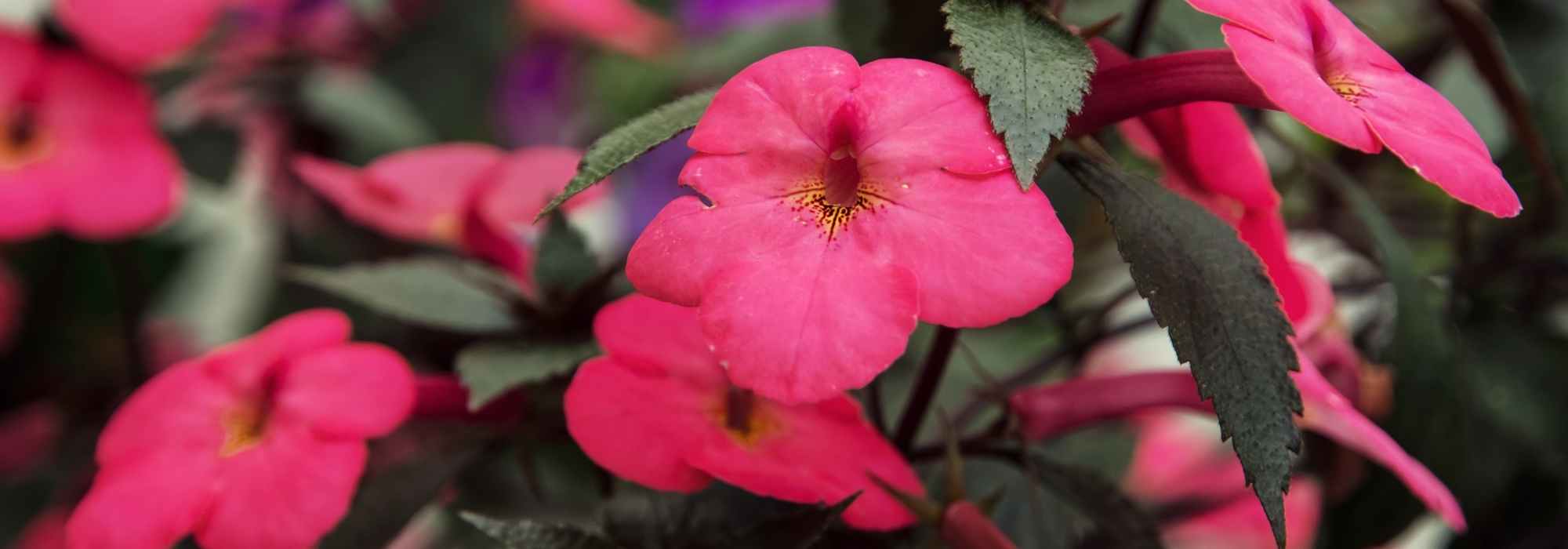
Achimenes: planting, caring for
Contents
Achimenes in a nutshell
- Achimene are tender tropical plants that are grown here as annuals in the ground or in pots kept warm
- They are also lovely houseplants, suitable for conservatories or greenhouses
- Their trumpet-shaped flowers provide a true colour spectacle from May to October
- They are easy to grow in partial shade in any good humus-bearing, cool, and well-drained soil
- With a trailing habit, they look wonderful in hanging displays
A word from our expert
Achimenes is a tender rhizomatous plant often grown indoors, but it is very floriferous! From May to October, it displays its trumpet-shaped flowers in a variety of colours ranging from blue to pink to pure white. Just like Alstroemeria, it is perfect for enlivening flower beds and window boxes for weeks.
With a trailing habit, it is valued for its use in hanging baskets and containers, although this vibrant and elegant plant also adorns low borders beautifully.
You can place it on the terrace or in the garden from June to August, in a sunny spot sheltered from the wind, or keep it indoors in a conservatory or greenhouse. In either case, its rootstock must spend the winter dry, protected from light and frost to be kept for several years.
Easy to grow, it thrives in non-burning sunlight, in well-drained yet moist soil, requiring only frequent but moderate watering along with regular fertiliser applications.
Fall in love with this lovely annual plant that is generous and beautifully coloured!
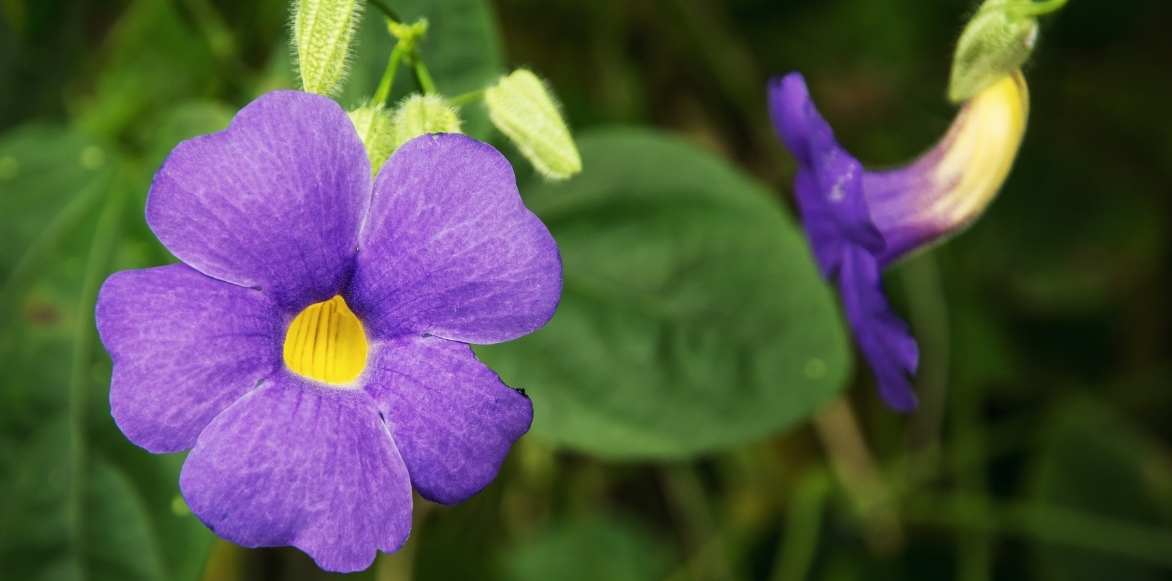
Blue Achimenes
Description and Botany
Botanical data
- Latin name Achimènes
- Family Gesnériacées
- Common name Achimène
- Flowering mai à octobre
- Height 0,30 à 0,60 m
- Sun exposure Mi-ombre
- Soil type Riche, léger, frais, bien drainé
- Hardiness Gélive
Achimènes are bulbous plants from the family of Gesnériacées. They are very decorative tropical plants but are frost-sensitive, originating from the Antilles, Mexico, and Guatemala. In the wild, they are found in slightly humid, semi-shaded areas on rocky slopes, sometimes at altitude.
Frost-sensitive, they cannot withstand temperatures below 10°C, and in our climates, they are often grown as annuals in the garden or in pots indoors.
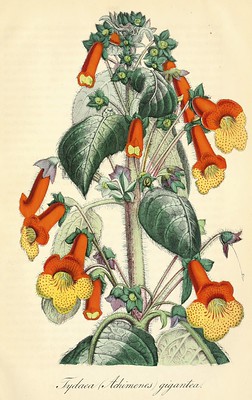
Achimenes gigantea, botanical plate from 1855
The genus Achimenes includes numerous species and varieties, constantly enriched by new hybrids. Among the most popular are Achimenes escheriana with its bright pink, almost fluorescent flowers, Achimenes grandiflora with long stems of 40 to 50 cm, and hybrid varieties that bloom abundantly like Achimenes x hybridum or ‘Ambroise Veschaffelt’, selected for the exceptional size of its flowers and its unique bicolour.
This rhizomatous plant quickly develops a rounded clump with a more or less trailing habit, about 30-50 cm high and 40-50 cm wide. With flexible but relatively brittle stems, it forms small, slightly trailing flowering cascades that look wonderful in hanging baskets and flowering pots.
The dense foliage consists of small deciduous leaves, ovate and pointed, with a lamina marked by purplish veins, measuring between 3 and 5 cm wide, slightly fuzzy, and dentate on the margins. They are a beautiful bright green, more or less dark depending on the varieties, and show a lighter, sometimes purplish underside.
Achimenes are characterised by a remarkably generous flowering. Although each flower lasts only a few days, the plant blooms tirelessly from May until the first frosts. The flowers open solitary in the axil of the upper leaves. They appear in the form of widely open trumpets, 2 to 5 cm in diameter. At the end of a long tube, the flattened corollas flare out into 5 spreading petals that are rounded or slightly pointed.
These large funnel-shaped flowers display cheerful and vivid colours ranging from bluish-purple to violet, including white, red, and all shades of pink. Some varieties stand out for their larger flowers or surprising tones, sometimes bicoloured. Their throat is often enhanced by a small halo of contrasting colour. A bouquet of prominent yellow stamens further brightens the colour of the corolla.

Achimene antirrhina (© cpf- flickr), blue Achimene (© koovery-Wikimedia commons) and bicoloured Achimene (© Leonora Enking)
Read also
Planting annualsMain species and varieties
The Achimenes were introduced to Europe in the 19th century, and successive hybridizations have given rise to lovely varieties ideal as veranda and indoor plants, as well as annuals to be renewed each spring in the garden.
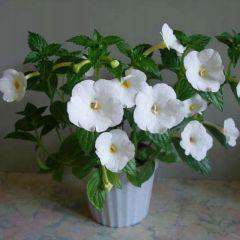
Achimenes White - Magic Flower
- Flowering time June to November
- Height at maturity 35 cm
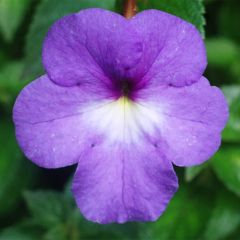
Achimene Blue - Magic Flower
- Flowering time June to October
- Height at maturity 35 cm
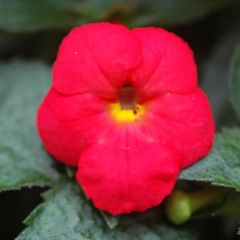
Achimenes Red - Magic Flower
- Flowering time June to October
- Height at maturity 35 cm
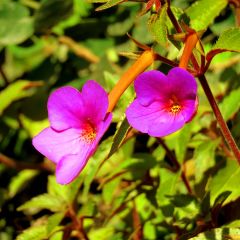
Achimenes Pink - Magic Flower
- Flowering time June to October
- Height at maturity 35 cm
Discover other Achimenes
View all →Available in 1 sizes
Available in 1 sizes
Available in 1 sizes
Available in 1 sizes
Available in 1 sizes
Planting of achimenes
Where to Plant It?
Achimenes is a tender perennial, rarely tolerating temperatures below -10°C. Although it blooms until frost, it is frost-sensitive and should only be grown outdoors during the warm season. As autumn approaches, the bulbs need to be dug up and stored away from frost. You can bring them out again as soon as temperatures rise above 15°C.
It can be grown on a terrace or balcony in pots or hanging baskets to be stored indoors during winter. It is often cultivated indoors from spring until the end of summer, in a conservatory or greenhouse at temperatures above 16°C.
Very floriferous and fast-growing, in the garden it requires light, slightly acidic soil that remains cool. It prefers sheltered spots from wind and scorching sun: bright partial shade is ideal.
Plant it in large pots that are wider than they are tall, in balcony boxes on the terrace or balcony, or in hanging baskets. It also fits well in perennial or annual flower beds, or to brighten up borders.
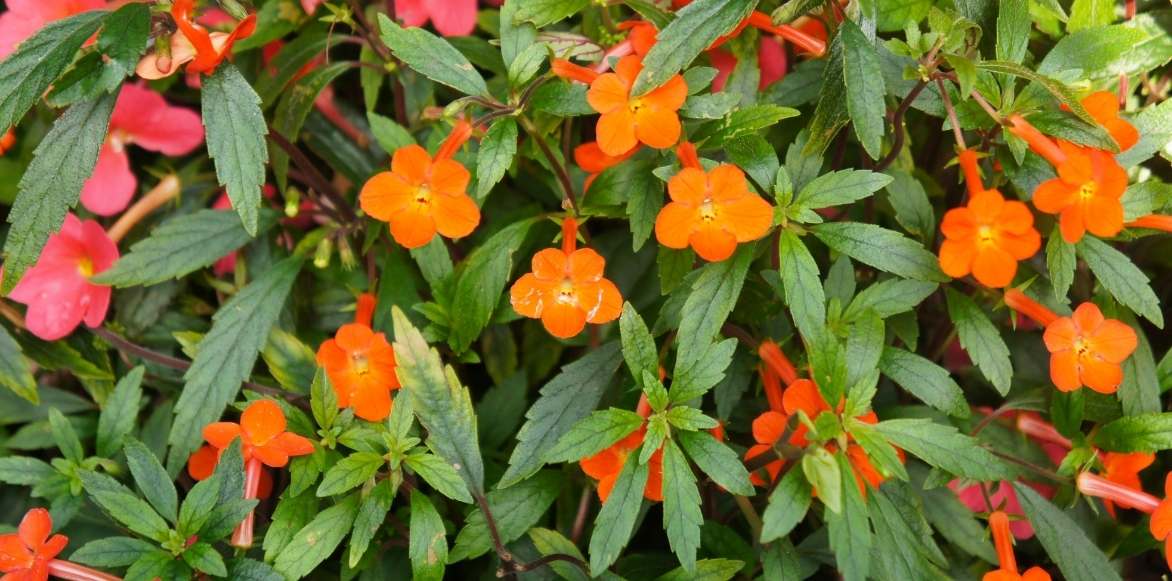
Achimenes admirabilis
When to Plant Achimenes?
Plant your achimenes bulbs in spring, either in the ground or in pots, once the risk of severe frost has passed, in April-May. The temperature must be above 15°C before planting them outdoors.
How to Plant Achimenes Bulbs?
In the Ground
The soil should be fertile, light, and well-draining.
- Prepare the soil with shallow digging
- Mix the extracted soil with heather soil, potting compost, and coarse sand
- Place the rhizomes 3 to 4 cm below the soil surface
- Firm down with your foot
- Water
In Pots or Hanging Baskets
Choose a pot that is at least 25 cm in diameter, capable of holding 5-6 rhizomes.
- Spread gravel or clay balls at the bottom of the container
- Fill the container with an equal mix of rich, well-draining potting compost suitable for geraniums, to which you have added a bit of heather soil and sand to lighten it
- Cover the bulbs with 3-4 cm of fine soil
- Firm down with your fingers
- Water with non-calcareous water (rainwater), and as soon as the surface soil dries out
- Place the pot in a well-lit room at 18-20°C or outdoors in partial shade in a bright spot
Cultivation and Care of Achimenes
During the entire growing season until September, outdoors, water regularly, two to three times a week, but without excess and without wetting the leaves. Too much water could lead to root rot. Indoors, however, regular watering should keep the substrate moist but not soggy, or the leaves may wilt. A careful balance is necessary. In pots, do not leave water in the saucers and maintain a good ambient temperature, between 16 and 18 °C.
Pinch the tips of the stems during the first month of growth to encourage the young plant to branch out.
Fertilise with a flowering plant fertiliser in the watering water once a month.
Remove faded flowers to encourage the appearance of new blooms and prolong the flowering period.
Achimenes bulbs are extremely frost-sensitive and fear freezing temperatures. At the end of the season, when the foliage is dry, it is necessary to dig up the rootstocks to protect them from frost.
In September, stop watering. Once the foliage has dried, cut it back. Dig up the Achimenes rootstocks planted in the garden, remove as much soil as possible, and store them all winter in dry sand in a box in a frost-free, dry, cool, and well-ventilated place.
If you wish to keep your pots for the winter, cut back the foliage, reduce watering, and then let the plant rest and dry from November to the end of February. Keep the pot in darkness. This resting period is necessary for the bulbs to rebuild their reserves. Around March, take the rootstocks out of the soil to change the potting mix, and replant them in fresh substrate. Place in a bright location and gradually resume watering.
Diseases and potential pests
Avoid excess water that encourages the appearance of fungi which can rot the roots and radically destroy an Achimenes plant. Aphids can attack young stems bearing buds: combat them with diluted black soap. Against frequent attacks from red spiders indoors, maintain sufficient humidity by regularly spraying non-limestone water on the foliage to keep a humid environment around the pot and spray preventively with nettle manure or a horsetail decoction.
Multiplication
Division of Rootstocks
At the time of repotting, use a sharp knife to separate the rootstocks, keeping only the healthy parts. Replant immediately in pots or in the garden if frosts are no longer a concern.
Stem Cuttings
- In summer, take 15 cm long cuttings from the tips of stems without flowers
- Cut each stem just below a node and remove the lower leaves
- Plant your cuttings in pots filled with a light mix of potting soil and sand
- Water regularly but do not saturate the substrate
- Keep in light and warm (minimum 20 °C)
- In spring, repot the cuttings
- Plant them in the ground or in pots after the last frosts
Associate
Indispensable in hanging baskets and planters, or for a summer in borders or beds, colourful and graceful, achimenes allow for elegant or vibrant combinations. At the edge of a summer bed, when paired with Petunias and Calibrachoas or mini petunias, they will highlight cleomes, rudbeckias, or cosmos. Their intense colours will be softened by grey-foliaged plants like Dichondra ‘Silver Falls’.
They create a striking effect alongside the lush blooms of petunias, surfinias, trailing geraniums, anthemis, heliotropes, or lantanas. In a flowerbed, mix them with small agapanthus, impatiens, and place them between begonias and fescues.
Very easy to combine in pots or hanging baskets, mix them with other annual plants like dipladenias and lobelias. For example, you can pair them with Plectranthus, a beautifully trailing groundcover.
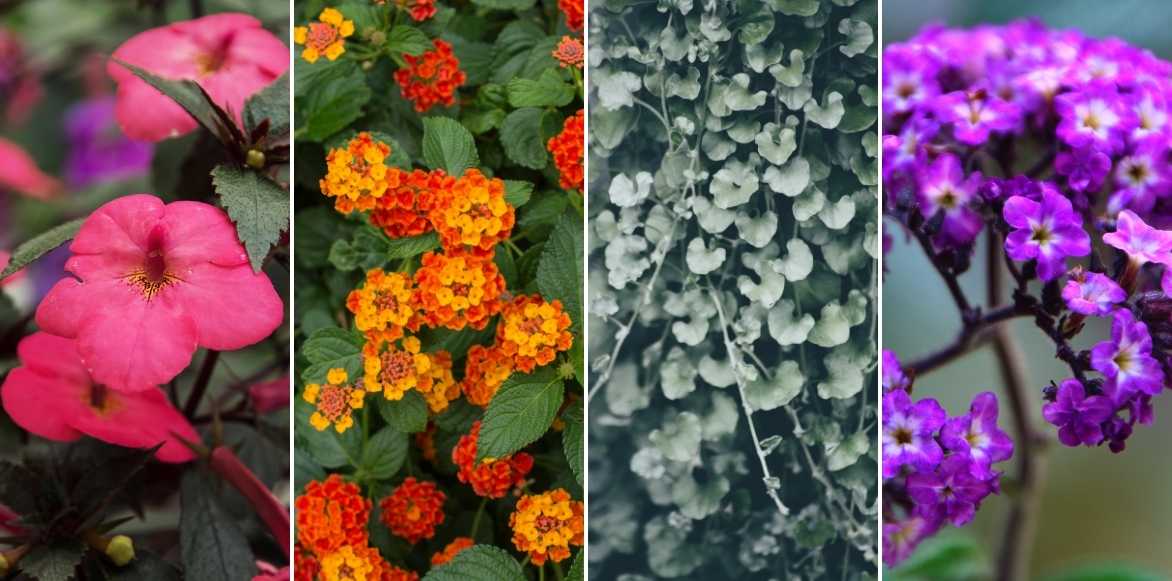
Achimenes alongside Lantanas, Dichondra ‘Silver Falls’, and Heliotrope
→ Discover 5 ideas for pairing achimenes
Useful resources
- Our best ideas for flowering your balconies and terraces
- Annual plants quickly dress the space they are given: discover our solutions!
- Discover our 7 pairing ideas to create beautiful summer planters
- Discover our unique selection of annual flowers!
- Subscribe!
- Contents































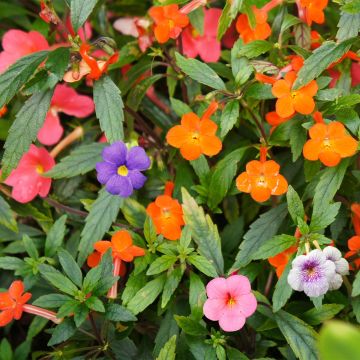




Comments